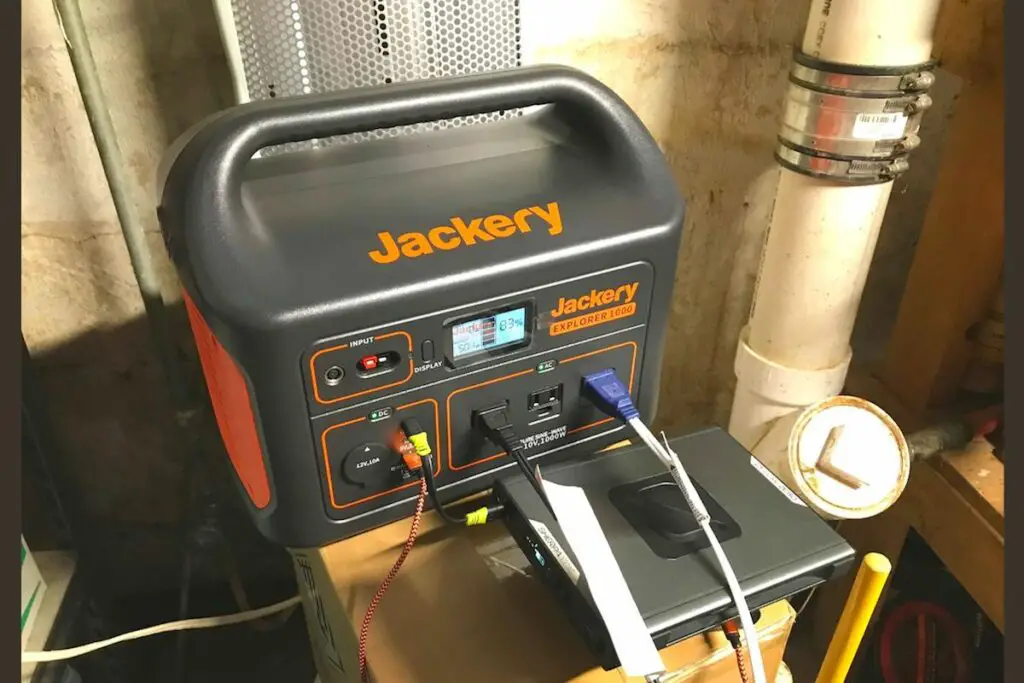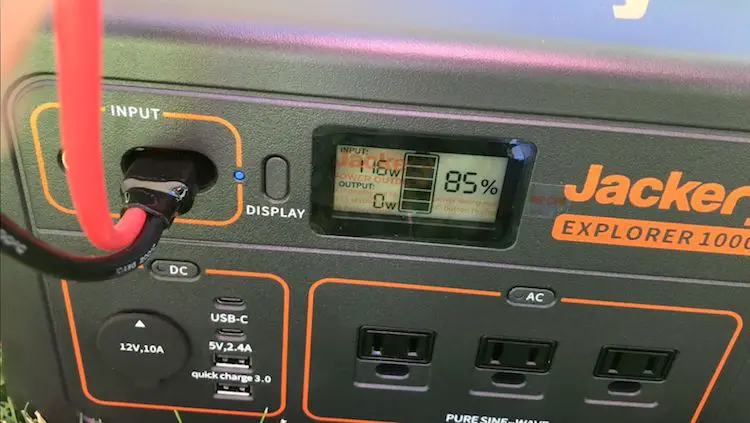After navigating Jackery’s more powerful solar generators, I found that the Explorer 1000 was much cheaper than their more powerful models and wanted to find out why.
So I did a little research.
| Pros | Cons |
|---|---|
| Lightweight for its size (22 lb) | Slow recharging |
| Good value for price | Average battery cycle life |
| Easy to use | USB-C port is only rated for 18W |
| 2-year warranty | LCD screen displays limited data |
The Jackery Explorer 1000 is a 1,002Wh portable power station with three AC ports, four USB ports, and one car port. It can be recharged from a car, wall outlet, or solar panels. Its AC ports are powered by an inverter capable of 1,000W continuous (2,000W surge).
The Jackery Explorer 1000 is best for tailgating, camping, and short-term partial home backup power. It is simple to use and its multiple AC and DC ports can run several different devices and appliances.
If you’re wondering if the Explorer 1000 is the right size system for your power needs, you can check out all of Jackery’s portable power stations in my Goal Zero vs. Jackery comparison article here: Goal Zero vs. Jackery – Battle of the Brands (Cost/Specs/Analysis).
Jackery Explorer 1000 – A Brief Overview

The Explorer 1000 solar generator comes from Jackery, a company founded in America, specializing in providing efficient and green off-grid power solutions.
With predecessors like the Explorer 160, Explorer 240, Jackery Honda HLS 290, Explorer 300, and Explorer 500, the Explorer 1000 is the most powerful of these systems with the highest power output and battery storage capacity.
Jackery’s portable power station lineup has expanded to include the larger Explorer 1500 and Explorer 2000 models.
You can find the Jackery 1500 compared to the Goal Zero Yeti 1500X in my article here for more information: Goal Zero vs. Jackery – Yeti 1500X vs. Jackery 1500.
The included features and specifications in the Jackery 1000 make it stand out as a reliable source of electricity in emergency situations.
Find the basic specs of the Jackery 1000 below. We will get into more specs and features later in this post.
| Year Released | 2020 |
|---|---|
| Avg. Amazon Rating | 4.9/5 (2,800+ ratings) |
| Where to Buy | Available on Amazon |
| Comes With | 1x Car Charger Cable 1x AC Charger Cable 1x Solar Panel Parallel Adapter Cables |
| Price (Subject to Change) | $999.00 |
| Cost per Watt-Hour (Wh) | $1.00/Wh |
| Battery Capacity | 1,002Wh |
| Battery Type | Lithium-ion |
| Battery Cycle Life | 500 cycles to 80% capacity |
| Weight | 22.04 lbs (10 kg) |
| Dimensions | 13.1 x 9.2 x 11.1 in (33.3 x 23.3 x 28.3 cm) |
| Warranty | 24 months |
Features of the Jackery 1000
The Explorer 1000 measures 13.1 by 9.17 by 11.14 inches and comes in a similar rectangle shape as Jackery’s other power stations.
It is relatively light for its size weighing only 22 pounds.
Being lightweight in conjunction with a strong and compact handle built-in with the product makes it very easy to move and carry about.
Jackery 1000 input section & LCD screen

On the product, the input section has two options: The DC input for AC and car charging and an Anderson input for solar charging (preferably two Jackery SolarSaga 100W solar panels or one SolarSaga 200W panel).
Beside these inputs is the LCD screen, which displays the input watts, output watts, battery percentage, and a battery icon showing the capacity of the battery at any point in time.
This section is completed with a button that activates/deactivates the LCD screen.
The Jackery 1000’s AC and DC ports
The DC section has the following options: a 12V car port, two USB-C ports, one USB-A port (5V 2.4A), and a 3.0 QC USB-A port. The AC section has three AC outlets rated at a combined 1,000W continuous (2,000W peak). Both the DC and AC sections have power buttons to activate their correlating ports.
| USB Ports | 1x USB-A port: 5V, up to 2.4A (12W max) 1x USB-A QC 3.0 port: 5-12V, up to 3A (18W max) 1x USB-C port: 5-12V, up to 3A (18W max) |
| 12V DC Ports | 1x 12V car port: 12V, up to 10A (120W max) |
| Regulated USB & 12V Ports? | Yes |
| AC Ports | 3x AC ports (1,000W continuous, 2,000W surge) |
| AC Inverter Sine Wave Type | Pure Sine Wave |
The only accessory that cannot be found on the product’s face is the LED flashlight, which is located on its side.
Similar: Inergy Apex vs Goal Zero Yeti 1000 – Which Ranks #1?
What can you power with a Jackery 1000?

The Jackery Explorer 1000 comes with an inverter rated at 1,000W continuous (2,000W surge) and a battery capacity of 1,002Wh. The Explorer 1000 can run a 900W toaster for 55 minutes and a 100W LED TV for 8.2 hours.
Appliances like microwaves and full-size refrigerators can be successfully powered consistently over a long period of time, as long as these appliances don’t exceed 1,000W.
Check out the table below to see what else the Jackery 1000 can power.
| Device/Appliance | Example | Battery Size (Wh) / Power Consumption (W) | Recharges / Run Time |
|---|---|---|---|
| Smartphone | iPhone 11 | 12Wh | 85 recharges |
| Tablet | iPad (6th Generation) | 32Wh | 31 recharges |
| Laptop | Samsung Notebook 9 Pro | 55Wh | 18 recharges |
| CPAP | IntelliPAP Standard CPAP Machine | 65W | 15 hours |
| 42″ LED TV | JVC 42″ 2160p 60Hz 4K UHD LED TV | 100W | 8.2 hours |
| Mini-Fridge | Frigidaire – 3.1 Cu. Ft. Mini Fridge with Built-In Freezer | 37W per hour on average | 22.21 hours |
| Toaster | Cuisinart CPT-122 2-Slice Compact Plastic Toaster | 900W | 55 minutes |
| Small Space Heater | Amazon Basics 500-Watt Ceramic Small Space Personal Mini Heater | 500W | 1.64 hours |
| Microwave | GE – 1.1 Cu. Ft. Mid-Size Microwave – Stainless Steel | 950W | 52 minutes |
| Full-Size Refrigerator | LG 26 cu. ft. 3-Door French Door Smart Refrigerator | 80W per hour on average | 10.27 hours |
| Standard Space Heater | PELONIS PHTPU1501 Ceramic Tower 1500W Indoor Space Heater | 1,500W | N/A (Jackery 1000 has max output of 1,000W continuous) |
Please note that I measured the AC appliances mentioned above with an 82% inverter efficiency. This means that the power consumed from the AC appliances totals about 82% of what the battery is rated for, which is 1,002Wh.
This is because the inverter takes some of the battery power to convert DC to AC power.
You can see that my measurements are accurate as seen in the video below. In the video, Will Prowse (YouTuber) calculates the Jackery 1000’s inverter efficiency.
I have the video queued at the part where he tests this out:
Can Jackery 1000 run a microwave?
The Jackery Explorer 1000 can run a microwave rated at 950W for approximately 52 minutes. However, it cannot run a microwave rated above 1,000W due to its AC inverter maxing out at 1,000W.
Several microwaves run at over 1,000W, so be sure to review your microwave’s power consumption reading.
If your microwave runs at exactly 1,000W or greater, it might be better to consider the Jackery Explorer 1500 because its inverter is more powerful at 1,800W continuous.
Can a Jackery 1000 power a full-size refrigerator?
The Jackery 1000 can power a full-size refrigerator (LG 26 cu. ft. 3-Door French Door Smart Refrigerator) for 10.27 hours. The amount of runtime that the Jackery 1000 can deliver to a full-size fridge depends on its daily power consumption.
I have an article on this exact topic where I put three different solar generators to the test against four different full-size fridges.
This post can give you an idea of the different refrigerator run times with and without its solar input being used daily.
Find it here: 3 Best Solar Generators for Your Fridge (With Run Times).
Can a Jackery 1000 power a small heater?
The Jackery 1000 can power a small space heater rated at 500W for approximately 1.64 hours. The Jackery 1000 can power any space heater rated at or below 1,000W.
Several large or standard space heaters run at 1,500W. This will not work with the Jackery 1000 but can work with their larger systems like the Explorer 1500 and 2000.
Can a Jackery 1000 power a toaster?
The Jackery 1000 can power a 900W toaster for approximately 55 minutes; however, it cannot power any toaster rated above 1,000W. It is best to avoid using 4-slice toasters with the Jackery 1000 because most average over 1,000W of power consumption.
Can a Jackery 1000 charge a car battery?
The Jackery 1000 can charge a car battery with the Jackery 12V PowerCable. It connects to the 12V car port on the Jackery 1000 and has alligator clamps on the other end to charge 12V lead-acid car batteries. It will not jump-start a car.
You can purchase the Jackery 12V Automobile PowerCable on Amazon (Affiliate link).
If you’re looking for a portable battery that can jump-start a car, I recommend reading my review of the Fanttik T8 Apex portable car jump starter.
I performed numerous tests on this jump starter and compared it to some other systems I found on Amazon for a full product review.
Check out my review here: Fanttik T8 Apex Car Jump Starter Review (Testing & Comparison).
Recharging the Explorer 1000 Power Station

Like all power stations, the Explorer 1000 doesn’t generate its own electric power. It is charged and stores electric energy.
The product is equipped with MPPT technology, which enables fast charging when the product is being charged with solar energy.
Below are the charging times and input parameters for the Jackery 1000:
| Input Ports | 1x Car/Wall port: 12-30V, up to 8.33A (163W max) 1x Anderson port: 12-30V, up to 8.33A (163W max) |
| Recharge Times | AC Wall Charger: 7 hours Car Charger: 14 hours Solar Panel Charging SolarSaga 100W X 2 (200W): 8 hours |
| Fastest Possible Solar Recharge* | 1,002Wh/163W=6.15 hours |
| Charge Controller Type | MPPT |
There are three main ways through which the Explorer 1000 can be charged.
1. Charging the Jackery 1000 from an AC outlet
You can plug the power station into a household AC outlet and your Explorer 1000 will be fully charged in seven hours.
2. Solar panel charging (two inputs in the Jackery 1000)
The next option, which is also one of the fastest, is to charge the power station with the aid of solar panels.
Here, the duration of the charge depends on the power of the solar panel in use as well as the amount of sunlight during the day.
A 200W solar panel with about 160W of power (80% efficiency) charges the power station in 6-6.5 hours, while a 100W solar panel with a power level of 80W will complete the charging process in about 12.5 hours.
View the table below for solar charging times in varying sunlight conditions.
Solar Recharging Times Based on Sunlight
| Perfect Sun | Mostly Sunny | Partly Cloudy | Cloudy | |
|---|---|---|---|---|
| Efficiency | 80% | 60% | 40% | 20% |
| 50W | 25.05 hours (40W) | 33.4 hours (30W) | 50.1 hours (20W) | 100.2 hours (10W) |
| 100W | 12.53 hours (80W) | 16.7 hours (60W) | 25.05 hours (40W) | 50.1 hours (20W) |
| 200W | 6.26 hours (160W) | 8.35 hours (120W) | 12.53 hours (80W) | 25.05 hours (40W) |
| 300W | N/A (input is too high for use in good sunlight) | 6.15 hours (163W – MPPT lowers original 180W to 163W max) | 8.35 hours (120W) | 16.7 hours (60W) |
Please note that the above solar panel ratings are for high-quality solar panels.
Jackery’s solar panels don’t just differ in power output ratings – they also differ in their efficiencies, at least for the SolarSaga 60W and SolarSaga 100W panels.
Check out the videos below, where you can see the variance in power output of these two panels in similar sunlight conditions.
I queued both videos to start towards the end because that’s where the total wattage is shown.
YouTube videos by electronicsNmore:
As you can see, the SolarSaga 100W panel performs at the exact same wattage as the smaller SolarSaga 60W panel in these tests.
If you’re looking to get the Jackery 1000 with these solar panels, choose the 60W panel because, from these tests, it performs the same as the 100W panel and costs less.
The cord from the SolarSaga panel goes into the 8mm charging input of the power station, while the cords for third-party solar panels are connected with the Anderson Powerpole input.
Similar: Top 5 Mistakes Newbies Make when Using Solar Panels
3. Charging the Jackery 1000 in your car

Your Explorer 1000 can be plugged into the cigarette lighter port in your car while you are driving using the DC charging cord that comes with the power station.
This is slower than the other forms of charging previously discussed, as it takes approximately 14 hours to charge using this method.
This is probably due to the fact that the car charging has a power level of roughly 80 watts. So if you are going on a long road trip, you can possibly use the time to charge your power station.
It should be noted that despite the presence of two charging ports, the power station cannot be charged through the two ports simultaneously.
What happens when you do this is that the power station charges through the primary source, which is the 8mm charging port.
It is only when the power source charging through that port stops that the other port starts charging the power station.
This means that if you plug the cable from a solar panel and also plug a power source through the 8mm port for charging, the power station will charge only through the 8mm port to the point where the power source charging through that port stops.
Is the Jackery 1000 Worth It?

The Jackery Explorer 1000 is worth it because it can be used for several different off-grid power needs and is competitively priced. It is lightweight for its size (22 pounds) and has multiple port options for charging devices and powering appliances up to 1,000W continuously.
The retail price for the Jackery 1000 is $999 (Amazon affiliate link). This is a fair price when compared with other power stations with equivalent capacity.
These power stations cost well over $1,000 at retail price, so the Explorer 1000 is offering quality at a competitive price.
To get a better idea on how much you should pay for a solar generator system, I recommend checking out my cost guide.
I give examples and an analysis of what to look for to get the best-priced system for your needs. Find the cost guide here: How Much Do Solar Generators Cost? (Pricing & Model Guide).
How Long Does the Jackery Explorer 1000 Last?
The Jackery Explorer 1000 will last 1.37 years until it reaches 80% of its original battery capacity if one entire battery lifecycle is used once per day. The Jackery 1000’s longevity depends on what you’re powering and how frequently you use it.
Here is a table showing the differences in lifespan of the solar generator (one lifecycle represents one full discharge and a full recharge of 1,002Wh with the Jackery 1000):
| Daily Battery Lifecycles | 1.0x Lifecycles Per Day | 0.5x Lifecycles Per Day | 0.3 Lifecycles Per Day | 0.1 Lifecycles Per Day |
| Years of Use Before Reaching 80% Battery Capacity | 1.37 years | 2.74 years | 4.11 years | 13.70 years |
How Heavy Is the Jackery 1000?
The Jackery 1000 weighs 22 pounds. Its 1,002Wh battery takes up the majority of this weight. The Jackery 1000 is nearly ten pounds lighter than the Goal Zero Yeti 1000X which has a slightly smaller 983Wh battery.
The Jackery 1000 is one of the lightest portable power stations for its 1,000Wh battery size range.
How Many Amp Hours Is the Jackery 1000?
The Jackery 1000 has a 46.4Ah, 21.6V battery. Its battery capacity is 1,002Wh. Its lithium-ion NMC battery combined with its AC inverter allow it to produce power at up to 1,000W continuous (2,000W peak).
Jackery Explorer 1000 Certifications
The Jackery Explorer 1000 has met standards in its manufacture and possesses the following certifications; FCC, RoHS, and UN38.3.
All these certifications are evidence of the quality components and professional expertise put into the manufacture and assemblage of the power station.
It is also important to note that there is a two-year warranty on the power station.
This means that if for any reason, not applicable to the user, the power station develops a mechanical fault or refuses to perform its expected functions, and the user is allowed to return the product to the manufacturer for repair or replacement.
Pros of the Jackery 1000 Power Station

Pro #1 – High power output
- At 1,000W continuous, the Jackery 1000 is able to power several high-demand appliances from its AC ports.
- This is one of Jackery’s larger portable power stations, and a larger system brings with it a larger power output – at least that’s how Jackery’s systems are designed.
Pro #2 – Large battery
- The 1,002Wh battery carries enough power to run appliances like CPAP machines and TVs for extended periods of time (8+ hours).
- This is essential for power outages at home or extended travel off the grid because you can charge/power most of the gadgets you need without needing to constantly recharge the Jackery.
Pro #3 – Lightweight
- At 22 pounds, the Explorer 1000 is lighter than any other portable power station in its 1,000Wh battery size range.
Pro #4 – Fair price
- At $999, this equates to about $1 per watt-hour of battery capacity. Compared to Goal Zero’s similar products, the Jackery 1000 is significantly cheaper.
Cons of the Jackery Explorer 1000
Con #1 – Slow recharge times
- The Jackery 1000 charges slower than other similar portable power stations. It has a max solar input of 163W, which is 197W less than the Yeti 1000 Lithium’s 360W max input.
- Since it takes a long time to charge from all of its various charging methods, it will not be able to continuously run certain appliances that need consistent power.
I made a list of the fastest-charging solar generators in a separate post. If this is a specification you’re interested in, you can check out the post here: Top 5 Fastest Charging Solar Generators (Via AC Outlet & Solar Panels).
Con #2 – Average cycle life
- The battery’s cycle life is greater than or equal to 500 cycles to 80% capacity.
- This is (in my opinion) a baseline for portable power stations. Jackery and Goal Zero power stations both have about 500 cycles to 80% capacity for the majority, if not all, of their systems.
- However, there are several solar generators from other companies that are much longer-lasting than the Explorer 1000.
- Also, LiFePO4 batteries are becoming more popular and offer a much greater cycle life than the Explorer 1000. This means that the Jackery 1000’s battery will not be able to last as long as any LiFePO4 battery of similar size.
Conclusion
Overall, the Jackery Explorer 1000 is a valuable portable power station to have. The main person this is for is someone who:
- Doesn’t mind slow charging
- Could use a lightweight system without sacrificing power output
You can find more of my thoughts on all of Jackery’s power stations and solar panels in my direct comparison to Goal Zero’s here: Goal Zero vs. Jackery – Battle of the Brands (Cost/Specs/Analysis).



